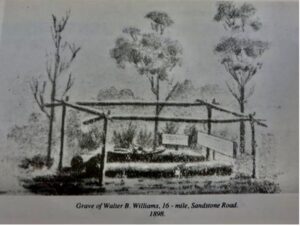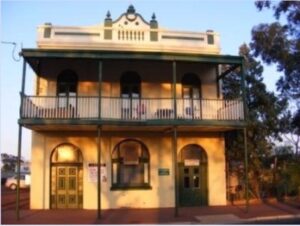The Demise of a Gold Prospector.

Sketch of lonely graves. (with permission of the Eastern Goldfields Historical Society, Western Australia)
Do you have any family history links to ghost towns or lonely graves? Whenever I encounter a ghost town or a lone grave, my imagination kicks into over-drive. What are the stories behind these ghost towns? At some time in the past, these towns were bustling communities with shops, hotels, and people going about their daily lives perhaps stopping to have a yarn with one of their many local acquaintances.
What about lone graves? If you ever travelled on the old ‘Flyer’, the steam train that travelled regularly between Sydney and Newcastle, you may recall that there was a lone grave around the Cowan district. Its existence haunted me over the years, as I wondered who was buried there and why were they buried there? Unfortunately, it was to remain an unsolved mystery as during the upgrading of the Pacific Highway in the 1960s’, the grave mysteriously disappeared.
In Australia we have an abundance of ghost towns and lone graves, many of them are the result of mining communities that have flourished and then diminished. When gold and other minerals were exhausted, and prospectors left, abandonment and neglect took its sad toll. They remain as evidence of the heydays of the gold rushes during the 19th century. Here in Queensland, there are many ghost towns the majority being located in areas where gold mining or other mineral mining occurred. Cracow, a gold mining town, is located 171 km west from Gayndah. Not totally abandoned, this old gold mining settlement attracts tourists like me who like to meander around the dusty, deserted streets and gaze at the ruins of empty houses once alive with folk who lived there.

Ghost Town of Cracow, Queensland. Image by author.
Here is a link to ghost towns located in Queensland. https://en.wikipedia.org/wiki/Category:Ghost_towns_in_Queensland#:~:text=Calcifer%2C%20Queensland,Wolfram%2C%20Queensland
I have also visited another fascinating and more recent ghost town in Queensland. In 1954, uranium was discovered in north-western Queensland between Mt Isa and Cloncurry. A thriving township was established by Rio Tinto Mining and named Mary Kathleen after the deceased wife of Norm McConachy who with Clem Walton made the discovery. Architect designed; Mary Kathleen was provided with a reticulated water system from a dam at Lake Corella.[1] The township was 6 km from the mine and featured a post office, cinema, sports ovals, a school, banks and a hospital. The population reached about 1200 at its peak but when the uranium reserves were fully extracted, it was decided to abandon the mine and close the town. Following an auction where the town’s buildings were sold and subsequently demolished and carted away, there was little remaining of this mining town.[2]

Hannah Brann/Pepperell. (1833-1899).
There are many more ghost towns in other parts of Australia. To seek them out, try researching the gold rush locations of the 19th century. Perhaps you have ancestors who were gold prospectors and lived in one of today’s many ghost towns. In 2016, I travelled to the eastern goldfields of WA, where many ghost towns and lonely graves can be found. Whilst there, I wanted to discover what happened to the second husband of my 2 x great grandmother, Hannah Pepperell. According to our family history, Mr William James Pepperell went to WA to seek gold in the 1890’s and never returned. With this unsolved family mystery occupying my thoughts, I was keen to discover some answers.
Prior to his new adventure, Mr Pepperell had been prospecting at the goldfields near Nundle in NSW where he met and married my widowed 2 x great grandmother, Hannah Brann in 1877. Together they operated an oyster bar in Tamworth before opening a fruit and vegetable business. However, Mr Pepperell was a victim of gold fever. For him, the thought of finding gold was irresistible and if he was lucky enough to strike it rich, they would be set up for life! In the early 1890s, when gold was discovered at Coolgardie and Kalgoorlie, he decided to travel there.
My efforts to discover a death record at the Western Australia BDM Registry office in Perth, ended in disappointment. Whilst at Kalgoorlie, I visited the local historical society and to my utter delight, I discovered so much more…
In 1895, Mr Pepperell was working with a syndicate of miners at Lawlers. Today, Lawlers is a ghost town but at its peak there were 12,000 souls inhabiting the town. It was late October 1895 when Mr Pepperell, volunteered to ride to Menzies for some much-needed supplies.[3] Taking two packhorses to ensure that he could return with ample supplies, he set off from Lawlers on the 230km/120-mile journey.

Menzies Hotel, Menzies. Image by author.
It was unusually hot for this time of year; scarcity of water was a serious issue, and many prospectors succumbed to thirst and dehydration. As Mr Pepperell approached the town of Menzies, he was struggling and starting to feel quite weak. Leading his horses along the main road in the direction of the Menzies Hotel, he staggered, his legs folding beneath him as he fell to the ground. He lay there motionless.[4] Passers-by rushed to his aid but were unable to rouse and revive him. Mr Pepperell was dead. An inquest held later that day, determined that James Pepperell died from apoplexy brought on by heat, thirst, and exhaustion.[5]
My next question became, “where he was buried?” Coincidentally, there was a report in the Coolgardie Miner, of a young man, Walter Williams, whose body was found on the Mount Ida Road, within days of the demise of Mr Pepperell, only 16 miles from Menzies. Walter had commenced his journey on a bicycle however the discarded bicycle was discovered some miles from his body. It was apparent that he too had died from thirst and exhaustion.[6]
Much to my morbid delight, I discovered that 16 miles out of Menzies on the Sandstone/ Mt Ida road, there is a lonely grave where lies the earthly remains of my ancestor, Mr Pepperell alongside the ill-fated Walter Williams.[7]
Unfortunately for me, our itinerary in 2016 didn’t allow for a road trip to see the ghost town of Lawlers or the lonely grave. Thank goodness for bucket lists! One day I very much plan to find those two lonely graves and also to visit the ghost town of Lawlers.
References
- Link to Queensland Ghost towns. https://en.wikipedia.org/wiki/Category:Ghost_towns_in_Queensland#:~:text=Calcifer%2C%20Queensland,Wolfram%2C%20Queensland
- Link to Lonely Graves of Western Australia.
https://lonelygraveswa.wags.org.au/ - Link to Outback Family history. https://www.outbackfamilyhistory.com.au/records/record.php?record_id=400
- Link to South Australia Lonely graves 1837-2005 FindmyPast. https://www.findmypast.com.au/discover/birth-marriage-death-and-parish-records/parish-burials/south-australia-lonely-graves-1837-2005
- Outback Graves Markers https://outbackgraves.org/burial-records/burial-search/?Name=Pepperell&Keywords=&action_OGMSearch=Search
[1] Australian Geographic, The Australian Town that was sold for its parts, https://www.australiangeographic.com.au/topics/history-culture/2024/05/the-outback-town-that-was-sold-for-parts/
[2] https://en.wikipedia.org/wiki/Mary_Kathleen,_Queensland
[3] ‘Tamworth District Court’, The Maitland Mercury and Hunter River General Advertiser, 15 February, 1881, np., http://nla.gov.au/nla.news-article815362.
[4] Sudden death at Menzies, ‘The Daily News’.(Perth, WA:1882-1950),p.3.
[5] ‘Inquest: Menzies’, Police Gazette, No. 47, 20 November1895.
[6] Another victim to Thirst, Coolgardie Miner, (WA: 1894-1919), 31Oct,1895.
[7] The Back Country Honors its Dead, Outback Family History, accessed https://www.outbackfamilyhistoryblog.com/

A wonderful story Bev!
Thankyou Fleur. That’s great that you enjoyed it.
Bev, this is so very interesting. I sometimes wonder about the forgotten graves on farms, and whether or not these are registered anywhere.
Hi Kerry, Yes, it is indeed. Here are a couple of links to lonely grave listings:
https://outbackgraves.org/burial-records/locations/
https://lonelygraveswa.wags.org.au/
In fact one of my convict ancestors was buried on a property at Warialda in an unmarked grave. I have seen the property where he was buried so I was most satisfied with that.